Illustration by Jennifer Tapias Derch
Inventory management is how brands organize and manage goods throughout the supply chain. No matter their size, all retailers will need an inventory management system to streamline the process.
Your inventory management system should help you maintain consistent stock levels and make it easier to ship products to customers. An efficient inventory management system is at the core of every successful retail business. But business owners sometimes use outdated manual processes that don’t integrate with the rest of their systems.
For high-growth merchants, managing inventory and orders through an ad hoc combination of spreadsheets, multiple apps, one-off workarounds, and in-house printing and record keeping can be crippling. Struggles with inventory and order management are a common theme among ecommerce icons like Death Wish Coffee, RIPT Apparel, and Shinesty.
So what’s the solution? Understand your business’s unique requirements, future goals, and how to choose the best IMS for you. This guide will walk you through it.
Table of contents
- What is an inventory management system?
- Types of inventory management systems
- Benefits of using an inventory management system
- Must-have features of inventory management systems
- How to find the best inventory management system for your retail business
- Best inventory management systems in 2022
- Choosing the right inventory management system
What is an inventory management system?
An inventory management system (IMS) is an integrated software program designed to track products, inventory, orders, and fulfillment both to and from customers, as well as with suppliers.It helps merchants track products along the supply chain.
High-volume ecommerce companies use IMSs not only to avoid inventory shortages but also to streamline and optimize their entire order fulfillment process.
Centralizing your inventory and order data is especially important for companies that sell across multiple online and offline channels, utilize multiple warehouses, or depend on kitting—bundling multiple items, often from multiple locations, which are sold and shipped as a single product.
Most leading inventory management systems include eight key components:
1. Order management
Inventory management systems make sure there’s sufficient stock to meet customer orders. The IMS alerts managers when stock levels run low or it automates the order fromwholesalersbefore the product runs out.
2. Inventory control
Effective inventory control helps you optimize storage space and correctly allocate financial resources to your stock.
3. Multi-channel sales alignment
An IMS synchronizes inventory data entry acrossmultiple sales channelsso you don’t need to estimate stock locations.
4. Comprehensive reporting and analytics
Advanced reporting and analytics tools highlight which products have the highest and lowest sales volume. These data-driven insights then influence future stock re-orders.
5. Volume forecasting
Using historical data, the IMS can make accurate forecasts and predictions on likely sales volume during any specific time frame.
6. Purchase order generation
An IMS can automatically create and send purchase orders to suppliers outlining the exact items it needs.
7. Multi-warehouse syncing
Syncing inventory data across all retailers’ warehouses ensures stock levels are at their most accurate.
8. Reorder point purchasing
The reorder point purchasing feature tells businesses when to reorder inventory so they won’t run out of stock. It usually triggers the purchase of a predetermined quantity of replenishment inventory.
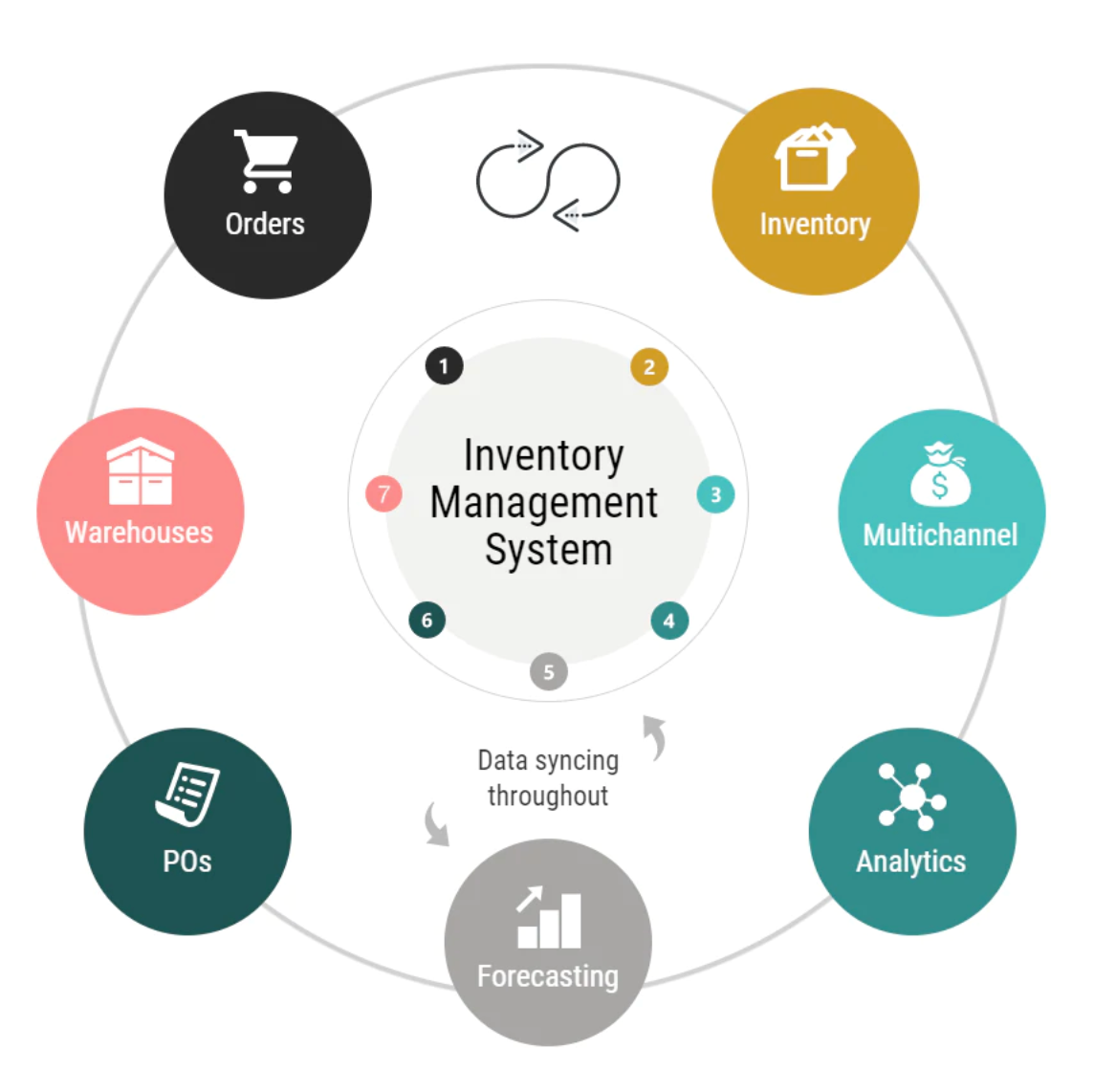
Fluctuations in demand, seasonality, supply-chain logistics and a product’s natural life cycle can all make managing inventory feel like trying to hit a moving target. Add to those challenges the complexities ofglobal ecommerce—namely, different taxation laws and currencies—and moving beyond spreadsheets and ad hoc workarounds become non-negotiable.
An IMS is an integral part of scaling your ecommerce operations throughthird-party logistics (3PL)。
Watch:3 Signs You Need a 3PL
Types of inventory management systems
Early inventory management systems were spreadsheets that stock managers had to manually update. Luckily, inventory management systems have evolved since then. Now retailers can automate most of their inventory management.
There are three types of inventory management systems:
- Perpetual inventory management systems
- Periodic inventory management systems
- Manual inventory management systems
Perpetual inventory management systems
A perpetual inventory management system tracks inventory in real time.When a product is sold, its bar code is scanned and it's removed from the inventory database. Similarly, when a new product is received, it’s scanned and added to the inventory database. Every part of the system has access to the central database and stock information.
永续盘存的管理的关键t system is that it offers an ultra-detailed view of inventory changes. It also provides accurate accounting of inventory levels without the need for time-consuming manual inventory counts.
It works well for all business sizes but is essential for retail stores with multiple locations or high sales volumes.
Periodic inventory management systems
A periodic inventory management system uses physical inventory counts at predetermined intervals to stay up to date.Businesses that use periodic inventory management systems won’t know how many products it has until after the physical inventory count is complete.
This way of tracking inventory is unrealistic for larger retail businesses. This is because when it comes to processing orders, you’re dependent on a manual stock count that was correct weeks or months ago. So when a customer wants to buy an item, someone needs to physically check your inventory to see if the product is available to sell.
Manual stock counts are time-consuming and use up valuable resources––your team’s time could be better spent on other tasks. Someone will need to count each and every SKU. A periodic system only works for small businesses with a lower quantity of inventory.
Manual inventory management system
A manual inventory management system is the old-school approach to managing inventory.手动库存管理系统通常是英航sed on a spreadsheet or even on pen and paper. While this may be a feasible option if your monthly sales are in the single digits, it’s not a sustainable option for growing businesses. Large retailers need a more robust option.
Kirsten Williams, the co-founder ofPod Star, a Shopify-based coffee capsule retailer, describes the moment she realized the business had outgrown its original manual inventory management system.
“In the early days, we would stop and count each box to find out stock levels at any given time,” she says. “We spent a lot of time trying to keep a spreadsheet updated, and there were times we didn’t keep on top of it and missed ordering new stock when we needed it.
“Running out of stock means no sales for that item. It meant lost sales and lost income. We progressed from our spreadsheet to an IMS. We’ve saved a lot of time in the packing process by usingBundleupto manage our inventory, and its stock accuracy is excellent. When processing returns, we can easily restock that item via Bundleup right on the Shopify app.”
Benefits of using an inventory management system
To run a profitable and efficient retail business, you need to have products in stock when customers want to purchase them. But between ordering inventory, sales, shipping, and storing, the whole process is complex.
An effective inventory management system will automate and handle the complex sides of inventory management so you can prioritize valuable resources for other parts of your business.
Here are the top four benefits of using an inventory management system.
1. Reduced missed sales
Stockouts cost retailers an estimated$1 trillionevery year. Not having sufficient inventory to match customer demand results in your business missing out on sales. Effective inventory management systems help you reduce missed sales.
Instead of second-guessing your stock levels, you’ll know in real time exactly how much inventory you have available to sell. A perpetual inventory management system updates inventory levels any time a product is purchased, sold, orreturned。
Having access to accurate real-time inventory enables you to evaluate inventory flow and order inventory when you need to. This helps prevent stockouts and missed sales.
2. Early detection indication
According to the Auburn University RFID Lab, the average level of inventory accuracy for US retailers is65%。That means more than a third of the time, the average retailer doesn’t know where a particular item is or whether they have it in stock.
Using an effective IMS should mean that you don’t even arrive at that point. Instead, it detects changes in inventory levels right away so you can make or automate the right stocking decisions.
3. Loss reduction
Automated inventory management systems give you real-time updates on where your stock is located. This visibility is especially important if you store stock in multiple locations, like different warehouses and physical stores. If you sell through several channels, your system tracks this too.
Accurate real-time data helps you keep tabs on your inventory at all times and helps reduce loss of stock through inaccurate data or tracking systems.
Without thorough tracking systems, it’s easy for inventory to go through the net unnoticed. For example, damaged stock may not be properly recorded, or inventory may simply get lost in large warehouses.
4. Lower warehouse costs
Warehouse storage represents large operational costs for retailers. But IMS can help you lower these costs.
Accurate inventory management software reports show you which products have the highest and lowest sales volume. By ordering fewer SKUs that have low sales volume, you’ll free up more of your warehouse space. You can instead use this space for storing inventory that has a higher sales volume—putting your storage space to better use.
Alternatively, your inventory management system reports may show that by stocking fewer products with low sales volume, you can downsize your warehouse and lower your costs.
Must-have features of inventory management systems
To give you the most effective solution, your inventory management system needs to have a few core features. While searching for an inventory management system, make sure it includes these core features:
- Real-time updating
- Assists in multichannel sales
- Demand forecasting
- POS
Let's dig into each in more detail.
1. Real-time updating
Real-time data lets you update your inventory levels the moment an order is processed. The best inventory management systems give you dashboards where you can see stock levels of individual products, your top sellers, and those items with lower sales volume.
This helps you manage your stock across all channels and locations, providing peace of mind that you know exact stock levels and their location.
2. Assists in multichannel sales
Support for multichannel sales is vital for stocking the correct amount of inventory for each channel.
By synchronizing all your sales and inventory data across all channels, you’ll get a clear picture of your stock levels.
Plus, optimizing your inventory control for each channel will help ensure you don’t experience issues with overselling or understocking. This helps improvecustomer experienceand sustain relationships with manufacturers andmarketplaces。
Knowing the exact location of your inventory—even if you stock products in different locations, either nationally orinternationally—helps lower the time needed to manually track individual items over your supply chain.
3. Demand forecasting
Accurately forecasting demand helps your business stock the correct amount of inventory for busy peak seasons when demand is soaring and make adjustments when demand is lower.
A robust inventory management system can analyze historical inventory and sales data to accurately forecast demand in future seasons. Depending on the system you choose, it may use casual forecasting or time series techniques.
4. POS
Inventory management systems that synchronize with POS (point of sale) systems are essential for maintaining accurate inventory records across all sales channels. This integration is particularly important for retailers with multiple physical store locations. Any time an item is sold in-store, your inventory management system will automatically update its stock levels in real -time.
Employees don’t need to spend time doing manual stock counts. Plus, automatically synchronizing your data like this helps reduce human error impacting your records.
How to find the best inventory management system for your retail business
Choosing the best inventory management system for your business depends on your business’s priorities and main requirements.
Here are some factors to consider while you research the right inventory software for your company:
Your business’s requirements
Each retail business will have a unique set of requirements for its inventory management system. Consider your list of requirements that your chosen inventory management system must have.
For example, online retailers may prefer a system that monitors product shipment status. Businesses with multiple physical stores will want a system with strong multichannel sales synchronization capabilities. Brands that sell products heavily influenced by seasonal demand will want software with advanced reporting and analytics tools to help improve their demand forecasting.
Shopify retailer Jen Greenlees, owner of kidswear storeSydney So Sweet, explains what requirements their brand was looking to meet during its initial search for an IMS.
“The most important was that the pick and ship could be run from iPads and that the picking screen included the actual catalog picture of the item being shipped,” Jen says. “This feature cuts our order error rate down to almost zero.
“As a small ecommerce business, the impression a customer gets when they open the first order from us is the most important, and it is absolutely critical to make sure orders are shipped correctly.”
Pricing
The cost of inventory software will depend on your business’s requirements. The more features and capabilities you require, the higher the price of the system.
Before you search for inventory management software, evaluate your company’s budget. Along with a recurring monthly subscription, you’ll need to consider costs associated with:
- Software installation
- Set-up costs
- Staff training
- Migrationfrom other systems
- Hardware needed for warehouses and stores
Cloud-based software has made it much more affordable for retailers to easily implement inventory management systems.
Integrations with other systems
精简你的零售业务,你的选择inventory management system needs to integrate (via API or otherwise) with the rest of your tech stack. At minimum, it should integrate with your ecommerce platform and in-store POS.
As your business evolves, you’re likely to add more platforms to your tech stack. Consider if your chosen inventory management system has enough available integrations to suit your future business needs.
For example, if you’re planning on expanding your warehouse storage system, look at whether your inventory management system will integrate with a warehouse management system.
Usability
It’s easy to get caught up in looking for advanced features, but don’t overlook a system’s usability. If it takes hours for your team to learn how to use its basic features effectively, it’s probably not worth investing in.
Remember, you’re looking for an inventory management solution to help you simplify your operations. Choose the intuitive easy-to-use one over the complex one.
Customization
Every retail business has a different setup in place. For your system to seamlessly sync with your business, it’ll need to be customizable. Check that the software can meet your business’s needs and how you can customize it.
If you’re already using an inventory management system, but need to upgrade to a new one with more features, check that the new system can easily combine with the current one.
Best inventory management systems in 2022
Choosing the best inventory management system can seem overwhelming. With so many available options, how do you choose one with the right features to help your business streamline its operations?
To help you find a solution, the Shopify Plus Partners Program has vetted a host of IMS providers. This list is certainly not comprehensive, but these are IMSs that, when aligned with your business’s size, growth trajectory, and industry, offer a starting point you can trust.
1. ShipBob
Best for direct-to-consumer (DTC) ecommerce brands.
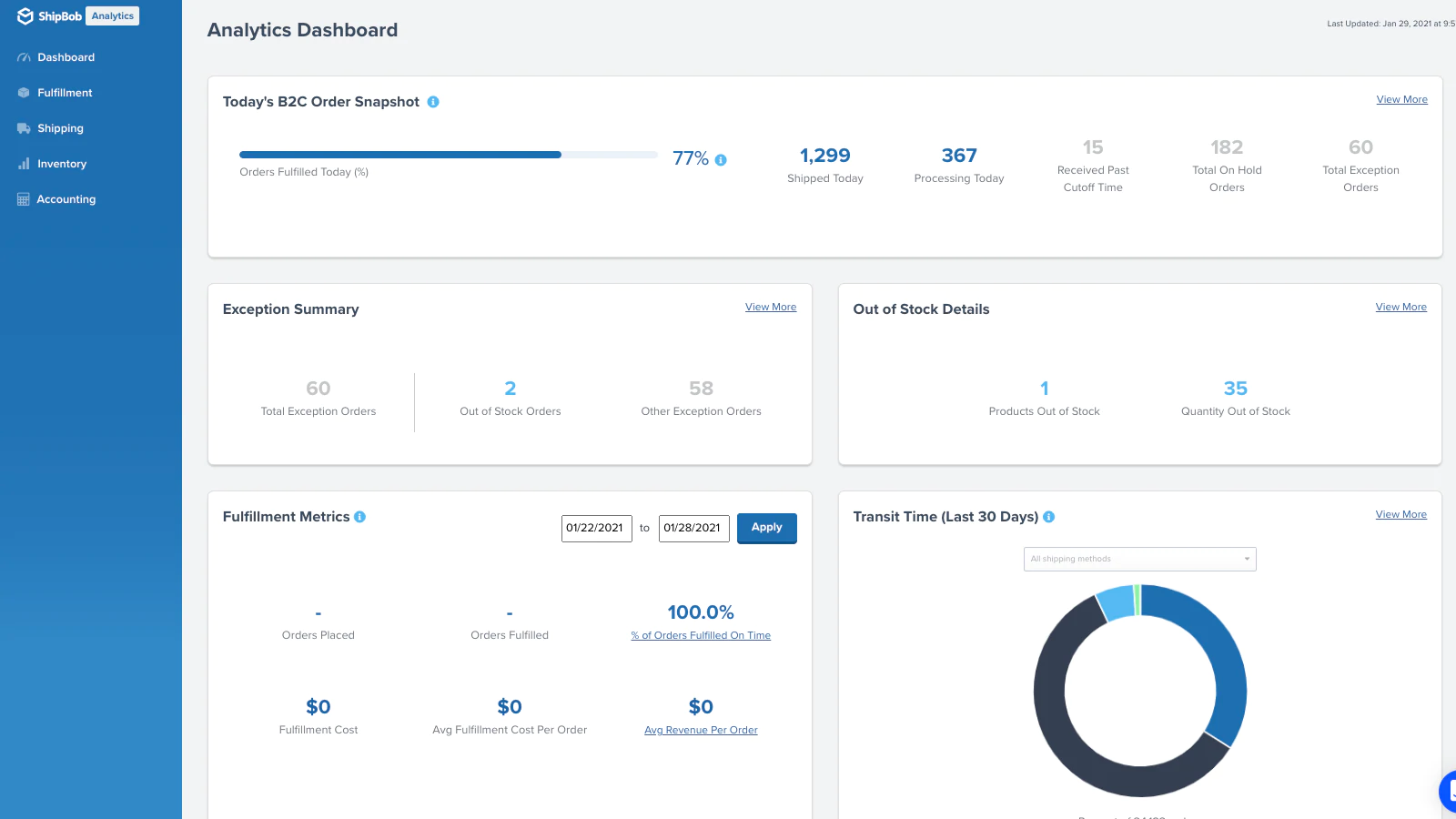
ShipBobis a 3PL service letting sellers store inventory in its network of warehouses—ShipBob manages fulfillment on their behalf. It acts as a single source of truth for your orders and inventory, so you’ll always know your items’ location.
One of the main perks for ShipBob customers is the fact you can strategically split your inventory across their warehouse locations, reducing the cost and shipping times involved with fulfillment.
All orders benefit from two-day shipping across the continental US—a serious advantage for customer satisfaction. Alongside this, you’ll find a full suite of warehouse management features like product warehousing, bar code scanning, distributed inventory, FBA preparation services, and more.
Key features:
- Easy integration with your Shopify store and ShipBob
- Automated order fulfillment and tracking information sync
- Same-day shipping
- Affordable two-day coverage of the entire US (and a growing international footprint)
- Simplified, transparent pricing based on delivery speed
Price:Starts at $1,850/month.
2. ShipHero
Best for growing and high-volume brands.
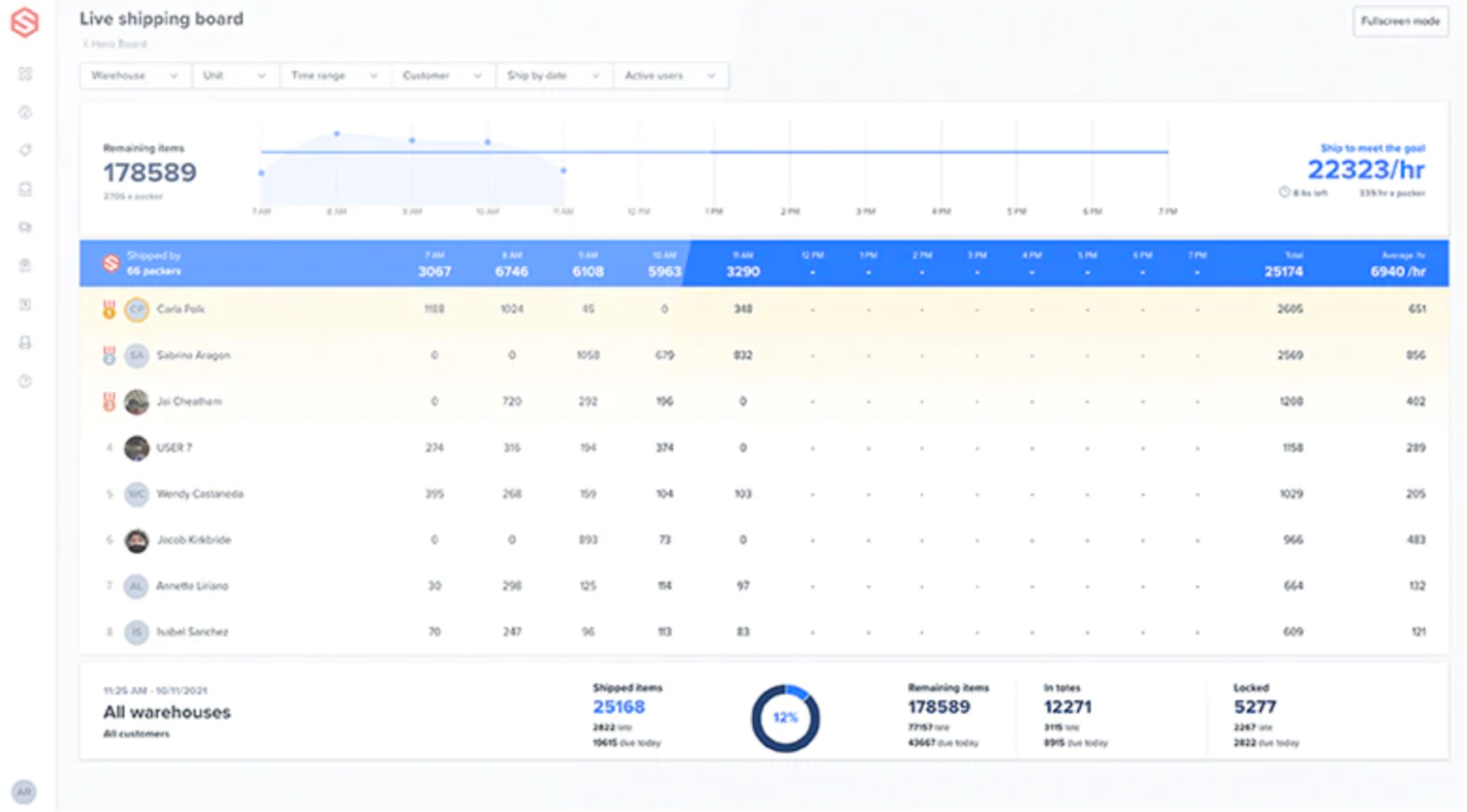
ShipHerois a multichannel IMS that ensures your inventory is never out of sync. By providing real-time information about stock levels, sellouts, and replenishment, it ensures you won’t be caught off guard during busy periods.
IMS的一面ShipHero wareh一同工作ouse management software, offering multi-warehouse order allocation, kitting, lot and expiration code tracking, and more. A range of automation functions makes life easier for anyone managing recurring tasks, too.
ShipHero works on a pay-as-you-go model, so there’s no long-term commitment.
Key features:
- Direct integration with Shopify
- Mobile picking, real-time carrier rate shopping, and bulk ship
- Personalized dashboard reports like Picker/Packer efficiency, COGS, and sales by SKU
- Bar code recognition, ticket scanning, and RFID
- Multi-channel management
- Supplier management functionality
Price:From $1,850/month.
3. Shopventory
Best for retail, food, and apparel brands selling online and in-store.
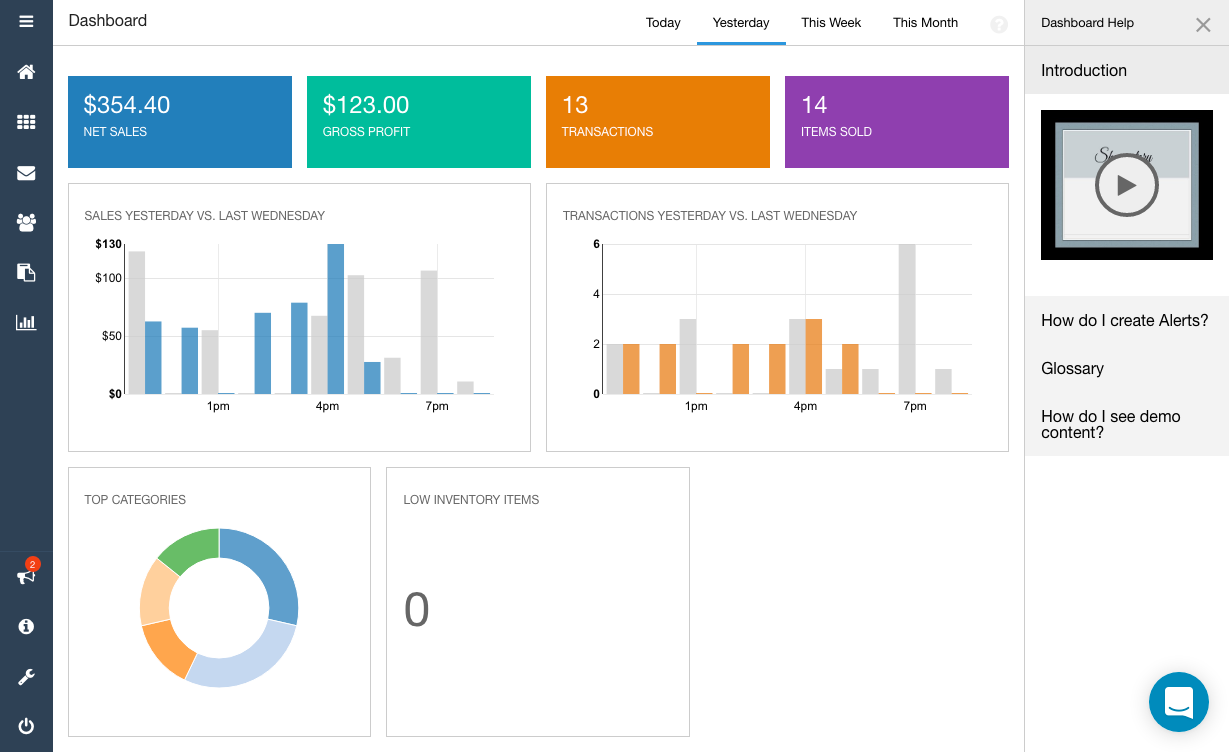
Shopventory是一个集中的基于云的IMS,让你男人age and sync multiple storefronts and locations. Data updates in real time, and your whole inventory can integrate with multiple POS and ecommerce systems.
There are also solid automation features, including purchase orders (when certain inventory items reach minimum/maximum levels) and smart inventory balancing across locations. It also has native applications for iOS and Android, providing bar code scanner functionality so you can check stock on your mobile device.
Shopventory shines when it comes to accurate inventory data: a rich suite of reporting tools helps you understand what’s going on with your stock throughout the supply chain. For example, view how many items you’ve got on the shelves, how this Black Friday compares to last year’s, or how profitable a certain product range is.
Key features:
- Reporting by location and channel
- Automated purchase orders
- Direct customer invoicing
- Simplified stocktakes
Price:From $99/month.
4. Stocky
Best for Shopify POS Pro customers and first-time IMS users.
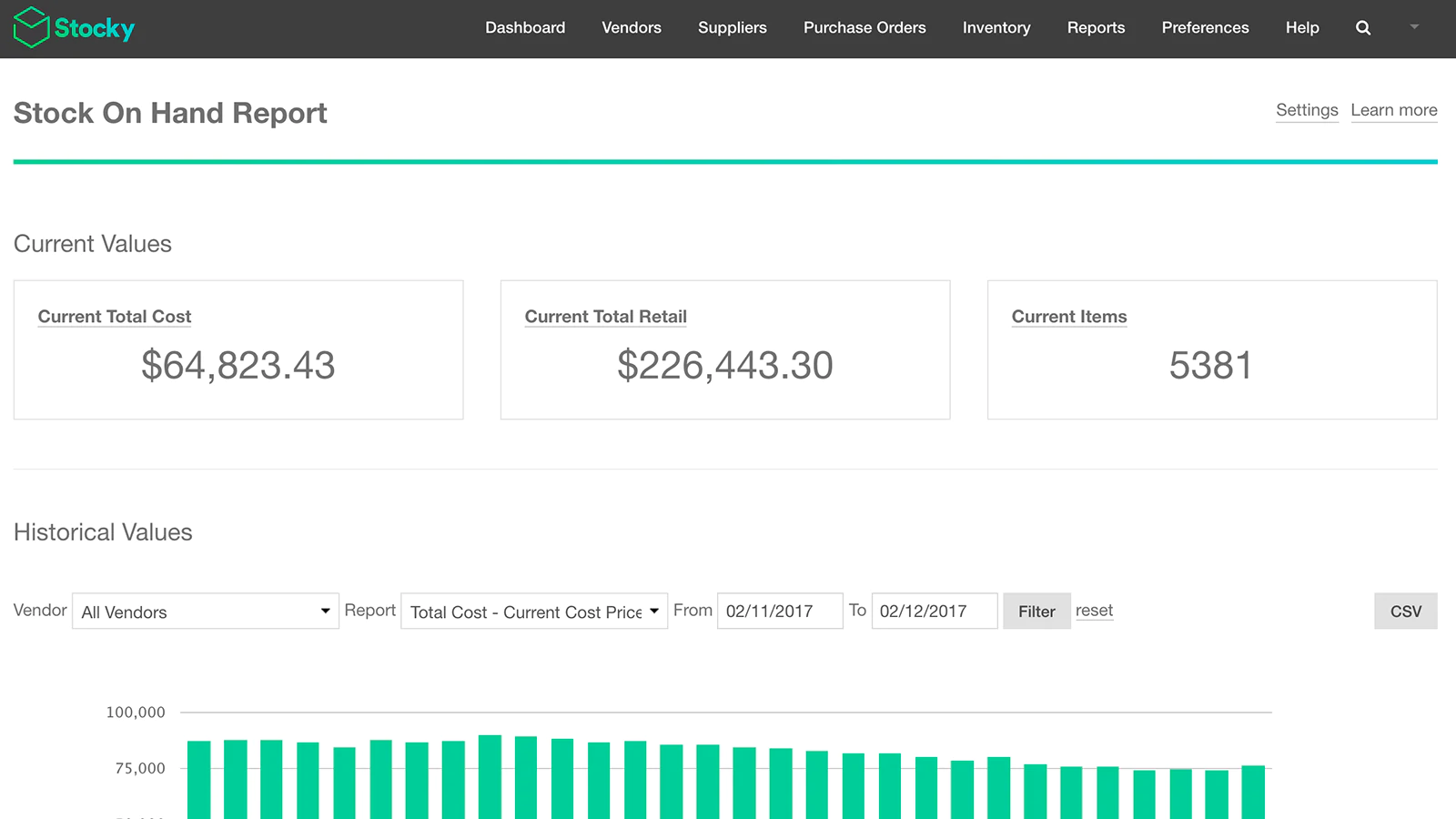
Stockyis Shopify’s own inventory management system, specifically serving users of Shopify Point of Sale (POS). If you’re using it to sell in person, Stocky will act as your IMS, handling all things inventory, so you can focus on the sales, not the stock keeping.
You can use it to create and manage purchase orders so your supply chain stays healthy, and replenish stock easily when you’re selling out. There’s a range of robust analytics, helping you understand which SKUs are performing best, and providing insights you can use to inform your sales strategy. It also helps you synchronize inventory across digital channels like Amazon and eBay.
For businesses that aren’t ready to invest in an external IMS just yet but want to move past manually updating stock in a spreadsheet, Stocky might be the perfect solution.
Key features:
- Create and manage purchase orders from one place
- Simplified demand forecasting based on rate of sales
- Easy stock transfer capability
- In-depth reporting and analytics
Price:Free with a Shopify POS Pro subscription.
5. Katana
Best for small manufacturers selling their own finished goods.

Katanais an IMS designed for sellers manufacturing their own products. You can use it to manage raw materials through production into the final product, all the way through to fulfillment to the customer. It’s an extensiveERP (enterprise resource planning)software that handles the whole production line, soup to nuts.
所以你会用它来记录你的资源,your production operations, and your outgoing products. It even handles floor-level operations like task planning and information management—all the features you need for manufacturing excellence. Behind all this is a powerful planning system that helps you maximize efficiency and profitability through the whole production chain.
Key features:
- Automatic data movement between Shopify and Katana
- Dashboards for visual production planning
- Real-time inventory control
- Floor control app to create and set up shop floor operators
- Stock sync between Shopify and Katana
- Multiple Shopify store support
Price:$99/month.
6. OrderHive
Best for growing ecommerce brands wanting to scale their operations.

Orderhiveis an IMS that’s focused on automating your inventory operations. It includes a ton of workflow automation that can greatly reduce the amount of manual labor you have to do across a range of business functions.
这可以包括航运标签的创建,updating stock, organizing products, and shipping out orders. With Orderhive, you’ll be able to see your stock movements through multiple channels in real time. It integrates with a ton of ecommerce platforms and shipping providers and can make some smart decisions on your behalf instead of putting the burden on you to micromanage everything.
Key features:
- One centralized inventory software for all back-end tasks
- Supports multiple Shopify stores in one Orderhive account
- Automated inventory updates, assignment and splitting, folderization, and fulfillment
- Real-time analytics and reports of your Shopify store’s inventory, orders, and customers
Price:From $95/month.
7. Netsuite ERP
Best for large companies operating multiple warehouses.
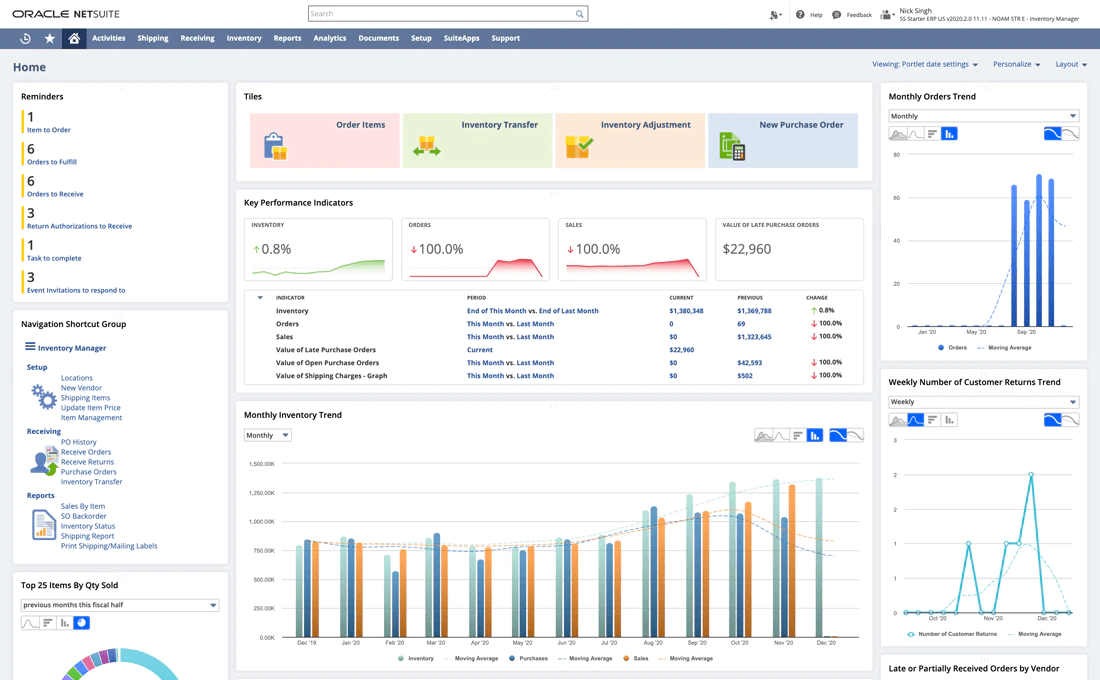
NetSuite Inventory Managementis part of Oracle’s ERP business management suite. It’s a multi-channel system that shows a real-time overview of your inventory across multiple locations. It covers your stock across retail stores, pop-up shops, 3PLs, warehouses, and more—the entire operation.
You can trace activities through every part of an order in granular detail to see where inefficiencies might occur. Or you can gain insight into the bigger picture, optimizing inventory levels based on demand planning and sales forecasts. Netsuite IM is available to Netsuite customers and has an annual license fee and a one-time setup charge.
Key features:
- Easily track inventory across multiple locations
- Real-time, company-wide inventory visibility across warehouses, retail stores, and 3PLs
- Lot traceability to track products from raw materials to shelf
- Automatic alerts for replenishment
- Auto assigns inventory count tasks to floor staff to improve inventory accuracy
- Inventory tracking using lot and serial tracing
Price:Custom, depending on requirements.
Choosing the right inventory management system
IMSs do more than manage orders and prevent stockouts. They streamline those management processes to save you time, money, and heartache. Logistics isn’t the sexiest growth topic. But it is one of the areas that dramatically affects your overall performance: for good and for ill.
Choosing the right IMS can mean the difference between more sales orders and happier customers … or the source of almost every problem in your working life.
To save yourself from that fate, be sure the IMS—or any 3PL—provides you with:
- Financial proof of long-term health and viability
- Recommendations and reviews highlighting both the good and the bad
- Integrations with accounting software like QuickBooks
- One-on-one referrals to contact their existing customers
- A track record of success in your industry and at your order volume
- Price quotes that include special features like gift wrapping, returns, and purchase orders, as well as how they monitor and deal with expiratory products (e.g., food and beverage)
Lastly, nothing can replace connecting with the IMS face to face to make sure everything checks out. Ready to take your retail business to the next level? Find theright 3PL to scale your business。
Inventory Management System + Software FAQ
What is an inventory management system?
An inventory management system is software designed to track products, inventory orders, and fulfillment both to and from customers as well as with suppliers.
What are the three types of inventory management?
- Manual inventory management systems
- Periodic inventory system
- Perpetual inventory system
What is inventory management software?
Inventory management software helps businesses control inventory levels and order fulfillment. There are many components of inventory management that the software enables users to track and optimize.
What are the benefits of inventory management?
- Reduced missed sales
- Early detection indication
- Loss reduction
- Lower warehouse costs
What is needed in an inventory management system?
Inventory management systems need to:
- Track inventory levels
- Alert business owners to high or low stock levels
- Sync across multiple sales channels
- Integrate with an ecommerce platform
- Create advanced reports
Why are inventory management systems important?
Inventory management systems are important because they can help forecast seasonal inventory, prevent overselling, reduce overall business costs, and improve supply chain management operations.






